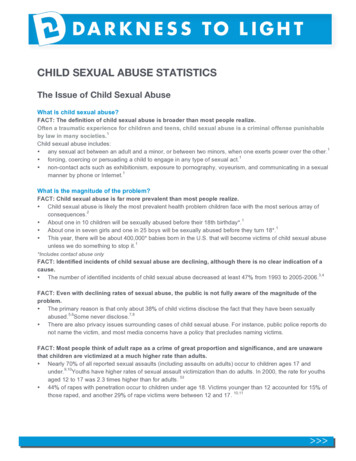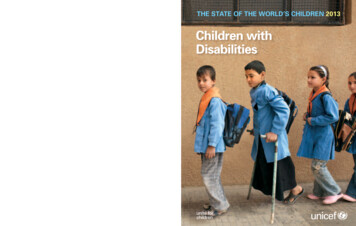
Transcription
Central Bringing Excellence in Open AccessJSM Health Education & Primary Health CareResearch ArticleExperiences from Parents toChildren with Diabetes Type 1*Corresponding authorMalin Rising Holmström, Department of Nursing, MidSweden University, SE- 851 70, Sundsvall, Sweden, Tel: 460-10-142-84-23; Email:Submitted: 13 November 2018Accepted: 26 November 2018Published: 28 November 2018Malin Rising Holmström*, Marie Häggström and Siv SöderbergISSN: 2578-3777Department of Nursing, Mid Sweden University, SwedenCopyright 2018 Holmström et al.AbstractOPEN ACCESSIntroduction: When a child is diagnosed with a long-term illness such as diabetestype 1(DT1) parents often find it stressful to give optimum support to the child and tomanage the situation especially when the child is in school. Parents experience that thestress to manage life with Diabetes Type 1, means to constant monitor blood glucose,to assist with insulin injections, food intake and physical activity, in order to optimumdisease management.Aim: To explore how parents’ of children with Diabetes Type 1 experienced theirrole as a parent.Keywords Child Diabetes type 1 Experiences Parents Interviews Qualitative content analysisMaterial and method: A qualitative design was used and individual interviewswere conducted with a purposive sample of 13 parents (10 mothers and 3 fathers) ofchildren with Diabetes Type 1. The interviews were analyzes using qualitative contentanalysis.Results and conclusions: The analysis resulted in one theme A life change revealingnew needs with four subthemes; Struggling with fear and searching for explanations,Learning to manage and getting control of a lifelong illness, Collaboration with schoolas an important support and Managing the illness influenced work and family finances.Parents in this study struggled for their children at all times, to be the child’s caregiverand to take care of the child’s life in the best possible way. They asked for flexible andcontinue diabetes education for themselves and for school staff efficient communicationand cooperation between parents/families, healthcare and school.ABBREVIATIONDT1: Diabetes type 1INTRODUCTIONWhen a child is diagnosed with a long-term illness likediabetes Type 1 (DT1), the life situation changes for the entirefamily [1]. Parents are responsible for managing the care of thechild and doing so parents experience a lot of stress. To managelife with DT1 involves supporting the child at all times, toconstant monitor blood glucose, to assist with insulin injections,food intake and physical activity in order to optimum diseasemanagement. Earlier research showed that looking after a childwith diabetes was a demanding experience for parents, wherethe illness experience was dominated by the ‘constant-ness’ ofthe disease [2]. Cousino and Hazen showed in a study focusingon stress among caregivers of children with chronic illness, thatparents of children with long-term illnesses reported greatergeneral parental stress, than parents to healthy children [3]. ASystematic Mixed-Studies Review showed the prevalence ofparental psychological distress across all studies ranged from10% to 74%, with an average of 33.5% of parents reportingdistress at diagnosis and 19% of parents reporting distress 1 to 4years after diagnosis. Furthermore, parental psychological stresshad negative effects on the child’s diabetes management [4]. Thisclearly indicates the burden and impact of the lives of parentswith children with DT1.In daily life, children spend a lot of timein school, and it is well described how parents can experiencechallenges interacting with school and healthcare professions toreceive support to manage the child’s DT1 in school and daily life[5-7]. School entry represents the first physical and emotionalseparation from parents and requires parents to trust that schoolpersonnel will be attentive and competent to ensure their child’soptimal health [8]. The schools cannot always meet children’smedical needs and needs for adjustments and parents striveto ensure the child’s environment in school can handle urgentsituations that may arise in connection to the illness [9]. In manycountries are school nurses and school health services responsiblefor the actually care of children with DT1 in schools [10]. InSweden the school health services and school nurses are locatedat the local schools and are a part of the school environment, butnot responsible for the care of children with chronic conditions[11]. Parents are the key persons in children’s management ofDT1 and how parents experiences being a caregiver is importantto highlight and understand to improve the care for chronically illchildren outside the hospital setting.Cite this article: Holmström MR, Häggström M, Söderberg S (2018) Experiences from Parents to Children with Diabetes Type 1. JSM Health Educ Prim HealthCare 3(2): 1044.
Holmström et al. (2018)Email: malin.rising-holmstrom@miun.se Central Bringing Excellence in Open AccessThus, the aim of this study was to explore how parents’ ofchildren with diabetes type 1 experienced their role as a parent.Table 1: Interview guide for parents.Qualitative design originated from a holistic traditionand seeks to understand people’s subjective perceptions andexperiences and was used for reaching the aim of the study [12].In line with this, data were obtained from individual’s interviews[13] and analysed with inductive qualitative content analysis. Themethod means that the analysis remained close to the text andconducted without preconditions based on parents’ experiences[14].Do you have a son or a daughter?MATERIALS AND METHODSParticipants and ProcedureA purposive sample of 13 parents (10 mothers and 3 fathers)participated in the study. Inclusion criteria in this study wereSwedish-speaking parents to children with DT1 (age 6-18years), with two years since diagnosis of DT1.The duration ofparents experience of child’s DT1 ranged from three to ten years(median 5) and the ages of the children with DT1 (six girls andseven boys) ranged from 6-18 years (median 11). Characteristicvariation were attempted by selecting parents, who varied interms of, gender (female n 10, male n 3), family structure(families n 9, separated n 4), prior diabetes experience offamily member/friends (n 3), insulin pump (n 11) or pen (n 2),diagnosis of gluten intolerance (n 3), and ethnicity (born inSweden n 9).School nurses from four municipalities in Swedenadministrated 30 letters with to parents of children with DT1.The letters consisted of information and aim of the study andan invitation to participate with a response envelope. Fifteenparents responded and were included in the study and the firstauthor contacted the parents to arrange a time for interviews.However, two participants chose not to participate due to lack oftime. Therefore, 13 parents were interviewed. The purpose wasto reach a purposeful sample with an even gender distribution,but it was difficult to recruit men in the study. Furthermore, thepurpose was to identify participants with a range of experiences(e.g., parents with diabetes or other family member) relevant tothe research purpose.Data collectionIndividual interviews were conducted with the participants.An interview guide (Table 1) was used consisted of three openquestions, Please, can you tell me about your experiences whenyour child got diabetes? Tell me about your experiences whenyou and your child returned to home and school? How did youexperience support? Participants were encouraged to share theirexperiences through follow-up questions such as: Can you givean example? What happened next? Two of the authors testedthe interview guide in a pilot interview, which was not includedin this study. The interviews were audio recorded, transcribedverbatim by the first author and lasted between 35–145 minutes(median 60). An introduction of the aim of the study was givenprior to the interview and background information was retainedfrom the participants. The individual interviews were conductedin Swedish in a quite environment of choice (e.g., in the publiclibrary, workplace, university), in January to June 2016 by theJSM Health Educ Prim Health Care 3(2): 1044 (2018)BackgroundWhen did your child get DT1?How old were your at the onset of DT1?Do you have several children?How is your family structure? (single or separated homes?)Are you born in Sweden?Do you have prior experience from diabetes or DT1? (Family, friends)Does your child use insulin pen or insulin pump?Does your child have gluten intolerance?QuestionsPlease, can you tell me about your experiences when your child gotdiabetes?Tell me about your experiences when you and your child returned tohome and school?How did you experience support?Can you give an example?What happened next?first author. Prior to the interview, written and verbal informationabout the study was given and informed consent was obtainedfrom all participants.Data analysisThe interview texts were subjected to inductive qualitativecontent analysis in line with Graneheim and Lundman [14]. Theanalyses were conducted in a conventional way without anysoftware. The unit of analysis focus how parents’ of children withDT1 experienced their role as a parent.The analysis occurred infive steps: (1) all interviews were read through several timesby the authors to get a sense of whole the content, (2) text wasdivided into meaning units (i.e. a word, sentences or a paragraphwith the same content) and condensed, (3) condensed meaningunits were abstracted: (4) abstracted meaning units were thenreviewed in relation to the aim of the study: and finally (5)compared and sorted into themes and subthemes based onsimilarities and differences in content. Throughout the analysis,there were on-going discussions between the authors to criticallyreflect on and review interpretations of the findings throughoutthe analysis. Finally, all authors met and discussed the analysisthoroughly and agreed the findings [14].EthicsPrior to the interview, written and verbal information aboutthe study were given and informed consent was obtained fromall parents. Confidentiality and anonymous presentation of thefindings were assured. The Regional Ethical Review Board, Umeå,Sweden (Dnr 2015/416-31Ö), approved the study.RESULTSThe analysis were based on individual interviews on how13 parents’ of children with diabetes type 1 experienced theirrole as a parent.There were ten mothers and three fathers inthe study and the duration of being parent to a child with DT12/7
Holmström et al. (2018)Email: malin.rising-holmstrom@miun.se Central Bringing Excellence in Open Accessranged from three to ten years. Three parents had prior diabetesexperience, one had diabetes type 2, and two had friends andrelatives with diabetes type 1 and type 2. The ages of the childrenwith DT1 ranged from 6-18 years. The family structure varied,nine parents lived in families and four parents lived as singleparents. Furthermore, ethnicity varied and nine parentswereborn in Sweden and four parents were born in another Europeancountry. All parents had experience of the insulin pen but 11parents reported using an insulin pump and two parents reportedusing the insulin pen. Three parents had experience of diagnosisof gluten intolerance as well as DT1.The analysis of the 13 interviews resulted in one theme withfour subthemes describing how parents’ of children with DT1experienced their role as a parent and caregiver. The theme is:A life change revealing new needs was constructed from the foursubthemes: Struggling with fear and searching for explanations,Learning to manage and getting control of a lifelong illness,Collaboration with school as an important support and Managingthe illness influenced work and family finances.The theme andsubthemes are presented below with referenced quotations fromthe interviews.A life change revealing new needsThe onset of the child’s DT1 was experienced as a lifechange for the all parents and the whole family. Life wouldnever be the same and parents identified new needs of supportand collaboration in order to manage the new situation to be acaregiver to a child with a chronic illness. All parents describedthe onset of the DT1 when how they struggled with fear andsearching for explanations, and later at the hospital learnt how tomanage and getting control of DT1, also realizing the illness waslifelong. When returning to everyday life all parents describedgood collaboration with school as important support and howthe life change also influenced parents work and family finances.Struggling with fear and searching for explanationsAll parents described the onset of the child’s illness very cleareven if it was a long time ago. They reported how they struggledwith fear and anxiety hoping the child would recover beforefinally deciding to seek medical advice. When the child got sickparents described how they felt instinctively that somethingwas seriously wrong, their child was not her/his usual self. Theyall observed the child and noticed increased thirst, urination,tiredness, weight loss and generally feeling ‘out of sorts’. Parent’sthoughts were occupied with trying to find logical explanationsfor the child’s changed behavior and they asked relatives, friendsand school personnel for support and advice what to do. Threeparents were terrified their child had got a deadly illness likeleukemia or a brain tumor and they goggled for the symptomsbut they did not quite match the behavior of the child. When theparents meet the healthcare professionals all parents expressedrelief when they got the diagnosis that their child has got DT1.They finally knew what was wrong with their child. All parentsdescribed it as a great support to meet competent professionalswho listened and handled the situation in a secure andexperienced way. The healthcare professionals made the parentsfeel safe and cared for, parents describe feeling included andnot alone with the responsibility being with skilled competentJSM Health Educ Prim Health Care 3(2): 1044 (2018)professionals. All parents described receiving continuousinformation regarding the planning of the care and being up todate helped and supported the parents to understand, to feel safeand prepare for the next step.“We were very well cared for at the hospital and receivedinformation fast .they listened to us .I was the expert on mychild”. (Mother-Son 7 y)Learning to manage and getting control of a lifelongillnessAll parents wanted to learn all about the illness to getcontrol of this change in daily life. They described how to learnto manage DT1 through observing, talking and asking questionsto the healthcare professionals, but also through the basiceducation given at the hospital by diabetes nurses and the wholediabetes team (i.e. a professional health care group who workwith children and youth with diabetes usually physician, nurse,nutritionist, psychologist, social counselor, and physiotherapist).A few parents describe it hard to learn how to inject insulin orto check the blood glucoses of their child and it was a turningpoint for them to adjust and learn to manage this. The parentsdescribed when they acquired more knowledge about DT1 theyalso realized their child’s illness implied a lifelong medicationand constant control.“It really hit me as a mother; my child needed these injectionsto stay alive”. (Mother-Son 11 y)The parents expressed that when they and their child camehome from the hospital, a new way of life began. Suddenly parentswere alone with the responsibility and no nurse to ask whenthey felt unsure. The food was described as an essential part tomanage and they had all meet the nutritionist in the hospital andhad discussed strategies to make daily life easier. Three parentshad experience of diagnosis of gluten intolerance as well as DT1and they experienced good support from the nutritionist whopresented new food options.One parent described this new way of thinking, as“You must learn to think like a pancreas”. (Father-Daughter12 y)All parents found that the diabetes education in the hospitalprovided them with a good basic knowledge but not sufficient tomanage at home. They expressed a need for more advice, helpand support at out-of-office hours. All parents reported seekingand finding support through social media such as Facebookwhich was available 24/7 in comparison to the support availablefrom healthcare.“‘Who is online at 2 o’clock in the night? .another diabetesparent”. (Mother- Son 13 y)All parents reported Facebook to be a good support especiallyduring the first year with DT1. Parents described differentFacebook groups were they exchanged experiences of everydaylife as a parent and how to handle challenges like conflictswith teenagers, getting a cold, food recipes, birthday parties,sleepovers and news about new insulin pumps. Parenting a childwith DT1 was sometimes frustrating as the children, especially3/7
Holmström et al. (2018)Email: malin.rising-holmstrom@miun.se Central Bringing Excellence in Open Accessteenagers, sometimes reacted negatively to increased parentalcontrol. Some parents described occasions when the childrenthreatened not to take their insulin or refused to eat and thesituation demanded a more authoritarian parent.“It is a powerful weapon to tell your parents that I do not careabout my DT1 . as a parent you get very cornered and you haveto act”. (Father-Daughter 11 y)Collaboration with school as an important supportA good collaboration with the school staff was a greatsupport for the parents and they all wanted to collaborate withthe school to ensure the right support for their child. This waseven more vital for parents of younger children with less abilityto be responsible for self-management. Parents experienced thata good communication with the school staff was vital to ensurethe safety for the child during the school day. Some parentsexperienced a great support from the school staff but someparents were not fully satisfied due to lack of trained school staffand substitute sin the classroom. Parents felt responsible fortheir child’s diabetes self-management at all times, even whenthey had left them at school and they supported the child’s selfmanagement by using mobile phones to stay in touch with theirchild and school staff. Some parents reported how the childrentook photos of their lunch and send to the parents who calculatedthe insulin dose needed. This use of modern technology wasexperienced as a great support from all parents. Iindividualisedcare plans from the health care were experienced as positiveby all parents. The care plans aimed to improve and supportdiabetes self-management in school, and reduce unnecessaryparental involvement during the school day. Some parents feltlike a messenger between the diabetes team and the school whenthe diabetes team told the parents how it should work in schoolto be optimal for the child, and the parents had to execute this incollaboration with the schools. All parents described they wantedmore collaboration with the diabetes team regarding educatingthe school staff. They describe that they had been absent fromwork to educate school staff. Educate the school staff was animportant way to ensure that the staff’s diabetes competence wassufficient to support their child.“Me and my husband have continuously initiated educationand training for school staff every year. We use our holiday toeducate school staff.” (Mother-Daughter 18 y)School nurses was described by some parents as a vitallink between school and diabetes team as a support in diabetesissues, to update care plans, to support education of school staff,to communicate with both the school staff and the diabetes team.Managing the illness influenced work and familyfinancesAll parents reported that managing the child’s DT1 affectedtheir jobs and some had changed employments to gain moreflexibility to support the child during the school day. Familyfinances were also affected due to work absences. Most parentshad applied for economical support in the form of a childcareallowance for children with a chronic condition. To get theallowance parents had to describe their child as dysfunctionaland this discouraged some parents.JSM Health Educ Prim Health Care 3(2): 1044 (2018)“I had to describe my child as dysfunctional as possible forwhat? .a small sum after tax not worth the time. I try to focuson the positive.” (Father- Daughter 12y)At the hospital, some parents had received support fromthe social counselor to apply for the allowance while othersgot support from other parents and social media. Overallparents described Sweden as a good place to live with an opensupporting society and legislation that increases understandingof DT1, which made it easier to get a well-functioning daily life,despite the diagnosis. They all described a good future for theirchildren but the parents hoped for increased knowledge in thewider society, so more people would know how to handle DT1and understand the need for support and individual adjustmentsfor their children but also for the family and parents.DISCUSSIONThis study has provided insight about how parents to childrenwith DT1 experienced their role as a parent and caregiver. Theresults show that it was a life changing experience for parentswhen the child got ill. Parents reported how the illness affectedthe whole family life and how they needed to learn how to managethe illness and also how collaboration with the diabetes team,and school, as well as social media was experienced as support.Regarding the subtheme struggling with fear and searchingfor explanations our results suggest that parents experiencedsupport when meeting competent health care professionalswho listened to the parents, included them in the care of thechildren and kept the parents up to date in the planning of thecare. This supported the parents and made them feel safe, andenabled the parents to prepare for the next step. This result couldbe interpreted as a way of empowering the parents by involvingand including the parents in the care and to give them structurefor the care, with similarities on how person centered care isdescribed [15].Regarding the subtheme Learning to manage and gettingcontrol of a lifelong illness our results suggest that parents hadto learn and understand the demands of the illness in orderto manage and getting control of the situation.The parentsdescribed when they acquired more knowledge about DT1 theyalso realized their child’s illness implied a lifelong medicationand constant control. For some parents it was a turning point torealize that it was a question of life and death and that the childneeded insulin to survive and the parent had to administer theinsulin. We argue that our results have similarities with how theconcept turning point have been described, as powerful emotionalexperiences leading to change in a person’s life. Furthermore theexperience from the parents could be regarded as a turning pointas described in earlier research focusing on in illness integrationand control of self-care among adults with diabetes type 2 [16].At home parents reported feeling alone with the responsibilityand no one to ask when they felt unsure. The diabetes educationgave a good basal knowledge but was not sufficient for challengesin everyday life such as parties or getting a cold for the first time.Furthermore, the parents experience the health care as inflexibleand hard to reach especially at nights or weekends. Social mediasuch as Facebook was always available for the parents andwas experienced as a support especially during the first year.4/7
Holmström et al. (2018)Email: malin.rising-holmstrom@miun.se Central Bringing Excellence in Open AccessEarlier research has shown that diabetes education needs to beadequately resourced and tailored to meet the needs of specificpopulations like the parents in this study [17]. The parents inthis study experienced need for a more flexible and continuousdiabetes education during the childhood years. Wennick andHallström [18] found family experiences of living with childhooddiabetes, triggered an ongoing learning process for the wholefamily and this corresponds well with parents reporting needingmore knowledge, seeking and finding support and advice, helpand support from different sources, the education given by thediabetes team but also through other parents and through socialmedia. These results are similar to previous research focusingon coping and care giving experience of parents of children andadolescents with DT1, where the highest score was obtained forseeking social support to cope with the parental burden [19].Some parents described occasions when the children threatenednot to take their insulin or refused to eat and parents experiencedthat the situation demanded them to be a more authoritarianparent then they were before. This change of the parental rolewere experienced as hard for some parents because they werenot used to this way of parenting their child and they felt as a badparent doing so. Earlier research shows that a more authoritarianparenting was associated with a better glycemic control [20].Nevertheless, this experience of being a bad and tough parentmight add to the parental burden and stress.staff themselves. Kime [24] has shown that parents felt that mostof the education of school staff, as well as care and support of thechild was left to them. For some parents this was experienced asa burden and they felt caught in the middle between healthcaresystem and school system. Lack of diabetes competence amongschool staff has been identified as a problem and an area fordevelopment in earlier research [25-26]. Furthermore, a studywith school personnel’s experiences of caring for youth withDT1showed lack of education and unclear responsibility to createfeelings of uncertainty and insecurity for school personnel anda need for mandatory education of school personnel regardingDT1 and self-care [23]. As mentioned earlier research has shownthat diabetes education needs to be adequately resourced andtailored to meet the needs of specific populations like parents orschool staff [17] and the result could indicate a need to unburdenthe parents from educating school staff.Establishing trusting relationships between parents, childrenand schools staff was found to be a key to success regardingcollaboration. All parents experienced school staff to be the mostimportant support for their child in school.This results couldindicate the need to further develop the collaboration betweenparents and school and earlier study has showed how meetingswith the school, parents and children, to have a dialogue and tofind strategies to support the child in school as a successful wayof establishing good and strong collaborations [23].METHODOLOGICAL CONSIDERATIONSRegarding the subtheme Collaboration with school as animportant support our results suggest that parents experiencedcollaboration with school very important, and parents put a lotof effort in this collaboration by being available at all times bymobile phone to support and help the child and the school staff.Parents experienced the use of mobile phones as an importanttool in the management of DT1 and were a great support and apossibility to be available for the child and the school staff withoutleaving their own work. The results in this study correspondswell with earlier research that showed parental involvementhad an improvement effect in blood glucoses control and selfmanagement for children with DT1 [21], as well as the use ofmobile phones led to improvement in glycaemic control and self‐management in diabetes care [22].Regarding the subtheme Managing the illness influenced workand family finances our results suggests that parents managedthe illness by being available at all times to support the child andthe school staff and that doing so affected the parents ability towork. Parents reported they had to be absent from work whenthe child was not well or when the school called and asked theparent to bring the child home. The family finances was affectedand some parents had changed employment or worked part timeto gain flexibility. In Sweden there is a childcare allowance forchildren with chronic conditions and most parents had appliedfor the allowance but with mixed feeling though the parents hadto describe their child as dysfunctional and some parents did notthink it was worth the effort and chose to focus on the positive.The findings suggests that even though parents had integratedthe illness in their lives, the family and parents was affectedesecially during the first year after their child was diagnosed withDT1. Despite this, they were also future-orientated and reportedthat a good life was possible with DT1. This is in line with earlierresearch focusing on understanding parent’s experiences ofliving with DT1 and striving for normal life [27] and the diseaseimpact on parents and children in terms of health-related qualityof life at diagnosis and 1 year subsequent to the child’s diagnosiswith type 1 diabetes [28].Educating the school staff was experienced with mixed feelingby all the parents becausethey had just learned themselves howDT1 should be managed to be optimal for the child, then they hadto execute this in the schools. Parents described the diabetes teamto be the experts, but the team had no possibility to visit schoolsbut offered schools education at the hospital. Unfortunately, itwas hard for school staff to participate due to schedules. Theparents experienced it vital that the school staff was competentand felt they had no alternative then to try and educate the schoolA qualitative design was considered most appropriateto answer the aim of the study hoping the results cast somelight on the studied phenomenon. Different steps were takenthroughout to enhance trustworthiness. By clearly describingeach step of the research process and presenting verbatimquotes co
continue diabetes education for themselves and for school staff efficient communication and cooperation between parents/families, healthcare and school. ABBREVIATION: iaetes te INTRODUCTION he a chil is iase ith a lter illess lie iaetes e the lie sitati c










